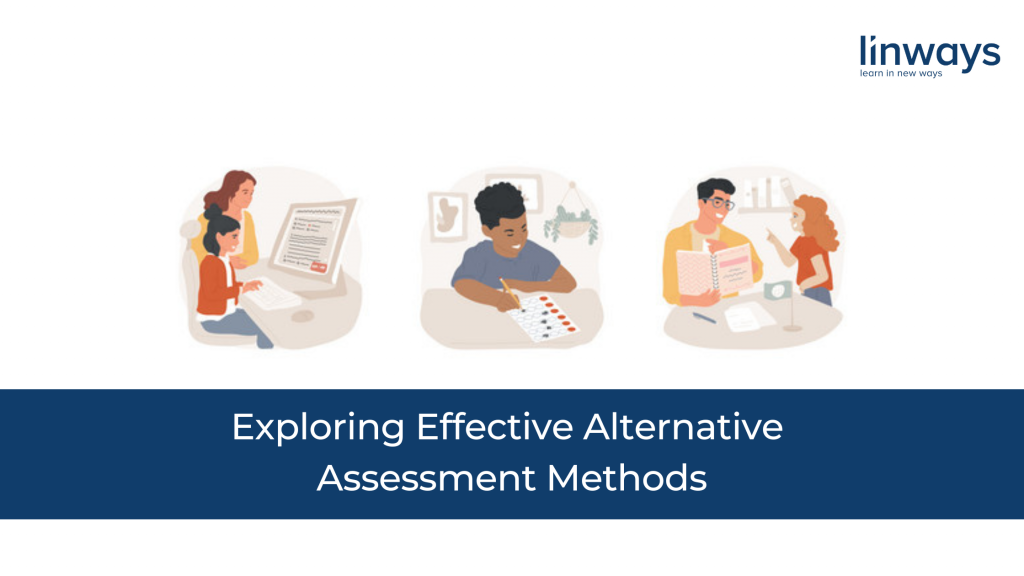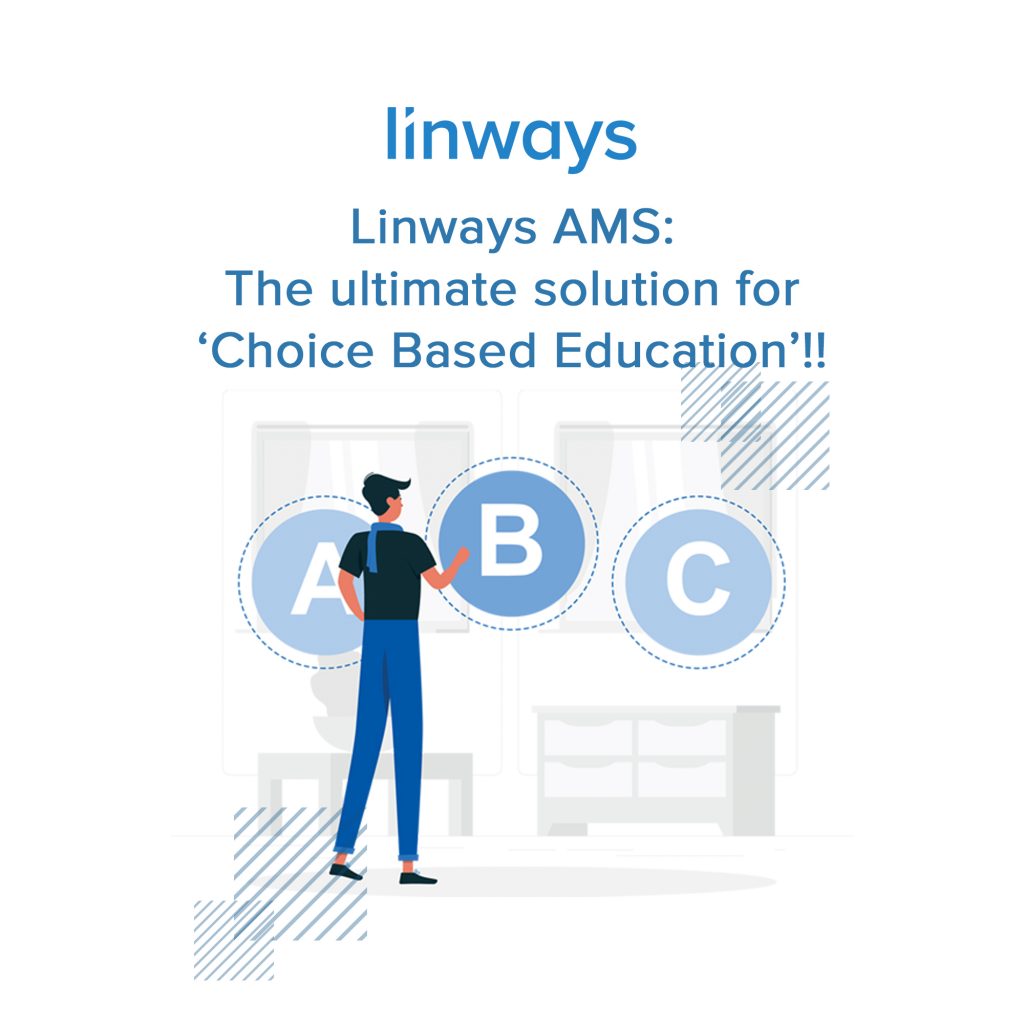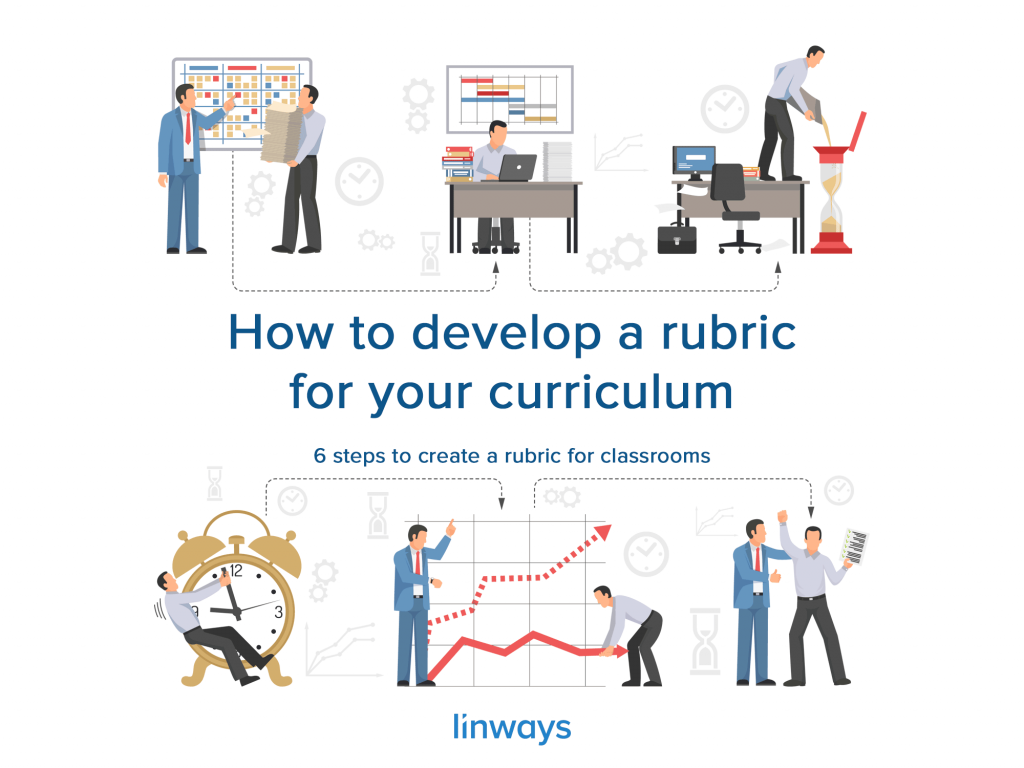
What is rubrics
Rubrics, in education, is an assessment guide used to evaluate learning. It’s a scoring guide, a set of criteria for grading assignments. Most formal education systems use some level of rubrics in their teaching-learning process to evaluate learners and assign grades/marks/scores etc.
Rubrics describes the level of quality for each learning assignment.
How Rubrics help to improve teaching-learning
Rubrics help teachers to focus on their goals and derive a concrete set of guidelines. Rubrics, in writing, is a guide for assessments and tests in learning quality. It helps to
- Set clear guidelines and targets for the classroom. This in turn will help to reduce time and energy spent on creating and tracking learning outcomes. Instead, you will be able to focus more on achieving them.
- Provide meaningful feedback that is clear, directed, and focused on ways to improve learning.
- Simplify outcomes and goals so teachers can focus on the work with better insights instead of guessing “what the classroom needs.”
- Adapt the teacher’s approach to the core learning principles of a course. It also helps to identify any missing links in student engagement and learning behaviors that shall be easily identified by drawing insights from rubrics of a batch/class.
- Develop consistency in how you evaluate learning outcomes and improve quality in teaching process.
Rubrics also helps students to have a better understanding of the course and assignments. So they will be able to contribute in a more meaningful manner. Since there are a clear set of criteria that the entire learning process is based on, it will help students to understand and appreciate various teaching methods, and offer better insights and useful feedback that the teacher can use in their advantage.
What does a rubric looks like
This is a tough one. Since a rubric is essentially a plan, it can be
modified, rearranged, and designed to suit unique needs and requirements
of a classroom, institution, or a teacher. However, leaning on popular
models and feedback from experienced academicians, we have prepared a
few classifications of rubrics that should give you an idea of how a
rubric looks like.
Classification
- Holistic rubric
Since this is a one-dimensional assessment scale, all the evaluation
criteria are considered together. With a holistic rubric, the teacher
assigns a single score based on an overall judgment of the student’s
work. Holistic rubrics works well when there is no one correct answer or
response for a criterion and the focus is on overall quality,
proficiency, or understanding of a specific assessment metrics.
During
assessment, teacher matches the student’s work as a whole to a single
criterion in the scale. However, an argument can be made that this type
does not leave room for detailed feedback on student work based on
multiple checkpoints or particular features of quality.
Here’s a generic model of a holistic rubric in action.
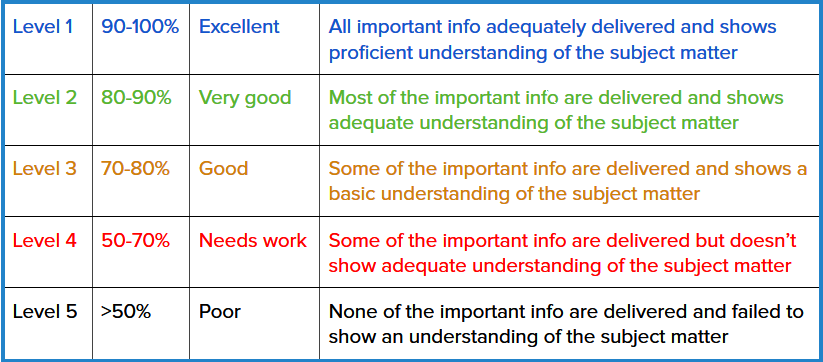
- Analytic rubric
This type of rubric is two dimensional. It’s like a grid where criteria are listed as columns and levels of achievement are featured in rows. This type of rubric is particularly helpful for assessing problem solving or application of information in various fields. The teacher assigns points for each criterion. If you want to gather insights on areas of strengths and weaknesses, this method is perfect. However, it takes more time to develop analytic model rubrics than a holistic model of rubric.
The analytic model also contain descriptions of what each criteria looks like for each level of performance. Each of the criteria is scored individually when scoring with an analytic rubric. You can assign different values to different criteria and conclude to the overall achievement score by adding up achievements of various criteria.
Here’s how analytic rubric looks like for multiple criteria

- Checklist rubric
Checklist is a distinct type of rubric that uses only two levels of assessment. As the name suggests, checklist rubric is a plain “Yes/No” or “Achieved/Not-Achieved” model. We use the checklist rubrics model to measure sub-criteria and quantitative analysis. For this very same reason, checklist model is longer than other kinds.
Checklists are easy to use and quicker to analyse. Using checklists also helps in reaching more consistent grading decisions over multiple times. For instance, all teachers know what the top performances look like and what the poor performances look like. But the middle is always unclear
Here’s a basic checklist rubric for your reference.
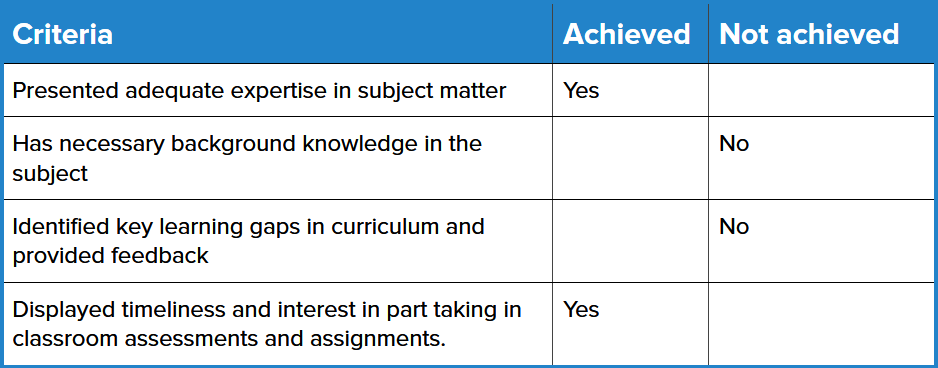
The important thing to keep in mind is that each of these rubrics can be even classified and divided to suit your unique needs and requirements. No two classrooms are alike, and no two students are similar. As a teacher, you need to adapt to the learning trends and revise your strategies every now and then to keep improving.
How to develop a rubric for your curriculum
6 steps to create a rubric for classrooms in the context of higher education
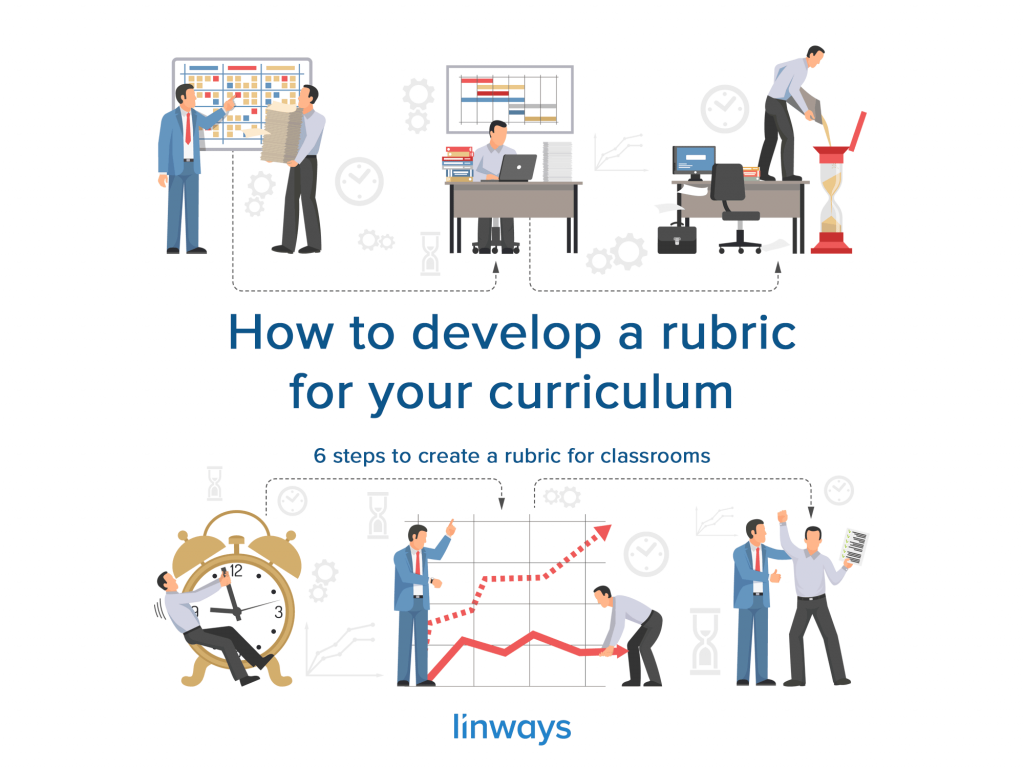
How to develop a rubric for your classroom
There are multiple steps involved, and creating an effective,
efficient, rubric is not an easy task. We have narrowed the process down
to these 6 steps to help you through the process.
Step 1: Define outcomes and goals for the rubric
Step 2: Choose the rubric type
Step 3: Define the assessment criteria
Step 4: Define the performance levels
Step 5: Write performance descriptions for each level of rubric
Step 6: Revise – reinvent – repeat
Now let’s look at each of those one-by-one.
Defining the outcomes and goals for the rubric.
The first step is to figure out your learning outcomes and goals for
the program/course. Building a rubric can only assist you if you have a
clear hold on what you are going to measure, and why. So write down the
learning outcomes early, before building the rubric itself. These
questions may help you better define your purpose and goals:
- What are the learning outcomes?
- Will you use rubric to assign a grade?
- How do you want to assess performance?; grades, marks, normalisation,
- What standards must the students hit in order to achieve acceptable or exceptional performance?
- Do I want to give one final grade on the project or a cluster of smaller grades based on several criteria?
- How will students demonstrate they’ve learned these outcomes?
Once you have answered these questions, it’s time to move on to the next step:
Choosing the Rubric type.
As we saw in the previous blog, there are essentially three types of
Rubric models present. Holistic, Analytic, and Checklist. There are also
other models evolved from these basic models too. But most of them are
way too similar to spent time discussing about it.
So from the insights you’ve collected from the first step, decide
which type of Rubric model might be the best fit for your classroom. You
don’t want to put too much pressure on this step because you already
have the necessary data to make the decision. You can also change the
model later if you want. Now to the next step, i.e.,
Defining the assessment criteria.
This is an important step in the development of a rubric. Your rubric
is as good as the assessment criteria it uses. So take enough time, and
write down every bit of detail you need for reaching the most
comprehensive set of criteria that you will be using to measure with the
rubric.
Based on the learning outcomes, define a key set of knowledge and
skills you need to assess. List out how you want your students to
display what they’ve learned, and you’ve arrived at the criteria! If you
prefer, here’s a list of questions to help your get started.
- What do you want students to learn from the task?
- How will students demonstrate that they have learned?
- What knowledge, skills, and behaviors are required for the task?
Combining the answers to these three questions will get you to the
criteria for the rubric. When you are ready with the assessment
criteria, it’s time to move on to defining the performance levels.
Define the performance levels.
The performance levels are broadly defined as to the extent to which
you want to score the assessment outcomes. This can be in grades, marks,
or any other methods that you see fit. Now unless you are using the
checklist method, which contains just the two rating levels, you shall
create and assign various performance levels to each of your criteria.
Deciding how many levels you’d want is more of a judgement call, but we
do recommend that you base your decision on the learning outcomes,
assessment criteria, and the purpose of building the rubric.
One thing you should remember while defining performance levels is to
keep the ratio between performance levels constant. (The difference
between a “1” and “2” should be the same as the difference between “4”
and “5.” Using different ratios for different levels might cause
confusion among students and create imbalances in your assessment
results.)
Once you have your criteria and performance levels, write performance descriptions for each level of the rubric.
Write performance descriptions for each level of the rubric.
This is a very important step in the process. In this step, you’ll
need to write specific statements that maps performance levels with each
criterion.
The descriptions should explain what criteria are met, and how well.
It should also provide insights into why the assessment levels are where
they are. For instance, a statement like “Communicated using excellent
language & displayed knowledge transfer capabilities” helps define
to what extend the criteria was achieved, and why the student wasn’t
awarded a higher grade.
If you’ve made it this far, we’ve got a solution that will help you simplify and streamline these processes with ease. Linways Academic Management System, is a platform that helps teachers, management, and the students to manage academics and simplify mundane daily tasks.
Linways helps teachers to build rubrics that are valuable in
improving quality in teaching-learning. With Linways AMS to support the
academics, all the assessments can be easily mapped with outcomes so
that their achievement can be easily calculated with minimal manual
labour. Teacher can also decide whether to share assessments with their
students or not, thereby improving student engagement and participation.
Linways AMS also supports rubrics-based mark entry which takes the workload off the shoulders of the faculty. The data related to the learning outcomes, curriculum, and students will be readily available on the platform. So creating custom reports, rubrics-based teaching methods, and detailed evaluation reports to collect meaningful insights is easy and error-free with Linways.
How do we use rubrics in daily academics
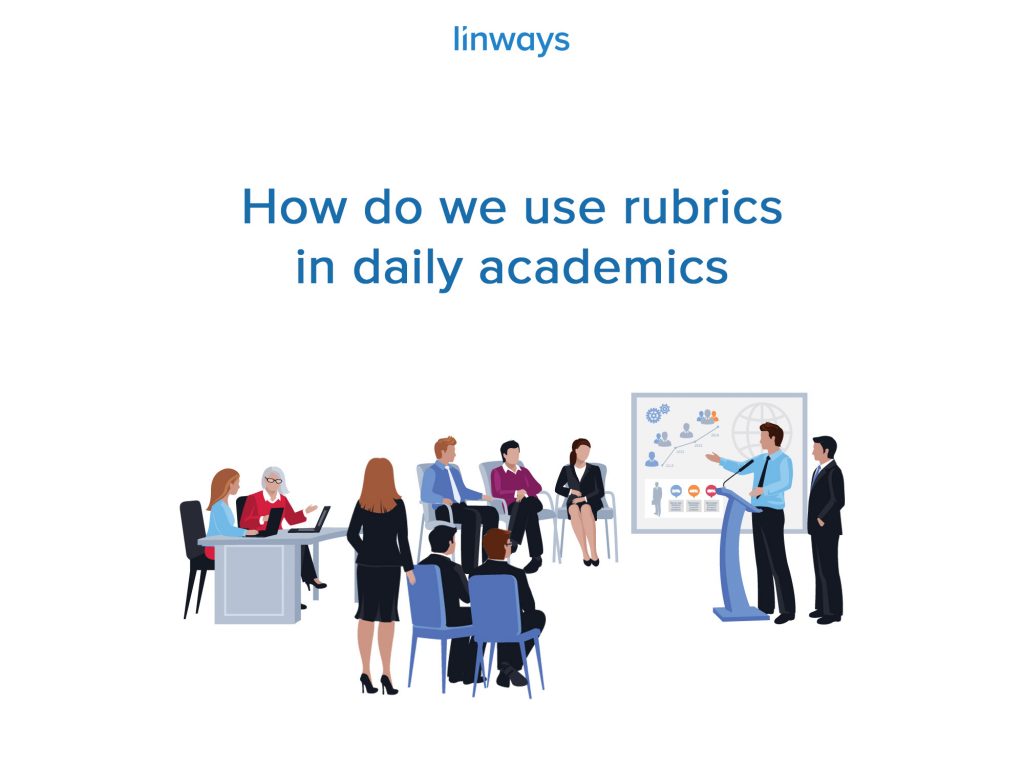
Here’s a few pointers while designing a Rubric scale.
Scale points
Before deciding performance levels take a moment to analyse whether
you are measuring competency, knowledge, or how much something was done.
Choose your scale accordingly. Writing down your needs and requirements
will help to define the scale and performance levels that fits well
with the class.
Dimensions
Dimensions are the performance indicators that tells you how if you
where does the performance stands on the scale. Ask yourself ‘what is
being demonstrated?’. Your instruction modes also should contribute to
determining the dimensions of the rubric. In a rubric grid, dimensions
determine the number of rows.
Descriptions
These are simple lines or paragraphs that define what each
performance level looks like at each scale point. In a rubric grid, the
description is the content describing and differentiating each slots.
You can define every performance level in various ways. One way is to
fill in based on demonstration in progressing from one end of the scale
to the other, while another method is to determine the anchors (highest
and lowest level demonstration) and then fill in the middle of the
scale.
These are all related to each other. You can define them
individually, but the scale points, dimensions, and descriptions
influence each other while creating. Sometimes if the descriptors does
not cover necessary performance levels, you have to add more scale
points. Or the number of descriptors are determined by the number of
scale points and descriptors.
How to use Rubrics effectively
Develop a different rubrics for different levels of assignments. It
might take some time to get on track, but once you are set with
different rubrics for different assessments, its very easy to manage
academics from there. Whether you develop your own or use an existing
rubric, be sure to test it with multiple use cases to ensure
reliability.
Integrate rubrics into assignments. Make the rubric a part of your
assignment. Share it with your students for better understanding.
You can also leverage rubrics to manage your time. Use the rubric to
gain deeper insights into student performance to prepare reports and
assessments over time. This is where you will save a great deal of time.
Be prepared to revise your rubrics from time-to-time. Decide upon a final grade for the assignment based on the rubric. If you find that rubric have exceeded or not met the overall qualities you’re seeking, revise the rubric for the next time. If the work achieves high values in some areas of the rubric but not in others, decide in advance how the assignment grade is decided the next time.
You may also consider developing online rubrics through your Academic
Management System, if it supports such advanced teaching tools. If you
are giving an assignment to be submitted as a digital copy, you can have
your online rubric mapped to that particular assignment, so that the
students submitting will directly correlates with other data in the
system..
The solution that we mentioned earlier that will help you simplify and streamline Rubrics is Linways Academic Management System. It is a platform that helps teachers, management, and the students to manage academics and simplify mundane daily tasks.
Linways helps teachers to build rubrics and map them to academics and assessments to enable proper tracking and report generation. With Linways AMS to support the academics, all the assessments can be easily mapped with outcomes so that their achievement can be easily calculated with minimal manual labour. Teacher can also decide whether to share assessments with their students or not, thereby improving student engagement and participation.
Also published on Medium.



